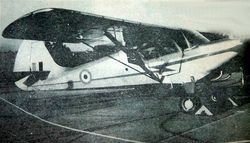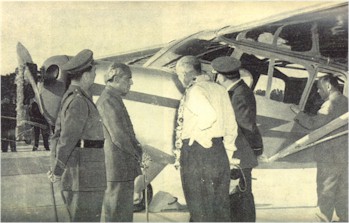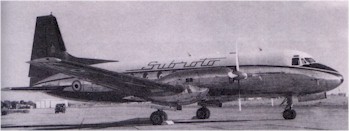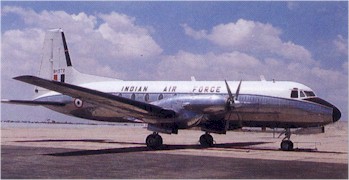The Indian Air Force is perhaps unique in producing aircraft within the service. It made two light aircraft – Kanpur I and II and then a few AVRO 748s. The latter were mainly for its own use. These were the result of the initiatives of just one man.
Having joined the Indian Air Force (IAF) as a Hawai Sepoy (Air Soldier), a rank lower than that of a soldier, Harjinder Singh rose to become an Air Vice Marshal (AVM). One of his many initiatives was the construction of an aircraft at IAF Station Kanpur in early 1958. It was probably flown on its maiden flight by Sqn Ldr BK Ghosh, test pilot, around March 1958. The aircraft was appropriately called Kanpur I. It was powered by a Lycoming 180 hp engine. This was the first aircraft ever manufactured by IAF. It was given the number BR-570, the digits 57 probably represented the year ’57 when work began on the aircraft. But it never officially became an aircraft in IAF service. We do not know which aircraft type Kanpur I one was based on. But almost certainly it was not an original design.
The Defence Minister VK Krishna Menon was invited to look at it. He came, he saw, he was overjoyed. He soon taunted Hindustan Aircraft Limited (HAL) in Bangalore. He said that HAL was the only aircraft factory in the country and yet had done nothing as impressive as IAF Kanpur. But the Director Technical Development & Production (Air) Mr Jagan Chawla was not impressed. According to him some very primitive production methods, especially in welding, had been used to make the aircraft and he refused to accord it an airworthiness certificate.
Stung by Defence Minister’s comments, HAL quickly made the Pushpak by copying the Aeronca Super Chief. The aircraft got ready within just sixteen weeks after being given the go ahead by Air Vice Marshal AM Engineer, MD of HAL. AVM Harjinder Singh lost the race to introduce Kanpur I as a basic trainer in flying clubs to the Pushpak. Kanpur I was eventually passed on to IIT Kanpur where it flew for a while to give experience of flying to students of aerodynamics and also to familiarise them with instrumentation techniques. The aircraft is believed to have disintegrated or broken up. Its wreckage is not traceable [1].
AVM Harjinder Singh then made Kanpur II (BR-571) powered by a Lycoming 250 hp engine. It was the same class as HAL’s Krishak (inspired by Aeronca Sedan). Meanwhile, the Army wanted an aircraft for Air Observation Post (Air OP) duties. In order to select an aircraft for the Artillery, a team was set up in January 1963. It was led by Gp Capt PC Ramachandran. I had a lot of respect for the Gp Capt. He had joined the Royal Air Force during World War II and at one time was doing test flying for Hawkers in the UK. I had heard the story (hopefully true) of his takeoff in a twin-engined aircraft in which the ailerons had been cross-connected. Amazingly, he brought the aircraft safely back. This is the only example I know of where a pilot managed to overcome his reflexes and use his brains to land back with incorrectly rigged ailerons. The same problem later killed the Chief Test Pilot of Saunders Roe in the last fighter aircraft the company designed.
Gp. Capt. Ramachandran (now retired Air Commodore) and his team flew the Auster AOP9, the Krishak and the Kanpur II. As the Auster would have had to be imported or produced under licence, the team was to basically choose between the Kanpur II and the Krishak. I gave the Gp. Capt. his first flight in the Kanpur II. A few sorties later he went up for an exercise calling for steep turns at a very low level to simulate Air Observation Post type of flying; While he was in a steep turn, the linkage to left aileron snapped. Again, he managed to retrieve the aircraft and landed shaken but safe. Jagan Chawla’s fears had been proved right. Construction methods of Kanpur II were just as poor as Kanpur I. Though AVM Harjinder Singh promised to rectify the problem, that was the end of the competition. He again lost to HAL’s Krishak Mk II. The latter became the Air Observation Post aircraft for the Indian Army.
Kanpur II also ended up at IIT Kanpur. It is still there, now grounded and in poor shape [2]. This aircraft is a suitable candidate for an Aerospace Museum. But HAL have set up their own Heritage Centre and Kanpur II obviously has no place in it. Perhaps the IAF Museum in Palam should acquire it as one of the aircraft manufactured by the Service.
Frustrated by these two failures, AVM Harjinder Singh decided to think big and make a DC-3 (Dakota) replacement. He considered only three candidate aircraft. These were the Handley Page Herald, F-27 Fokker Friendship and the AVRO 748. The first was given up, as it did not seem to find favour anywhere. The F-27 was examined carefully. Its construction required bonding methods which would have meant air-conditioned hangars. On that one count alone it was also rejected. This left the AVRO 748 as the sole contender. The AVM tackled Krishna Menon in the UK and convinced him that the aircraft could be manufactured in IAF Kanpur Perhaps the Defence Minister believed himself to be the man responsible for creating an organisation to make transport aircraft in India. The AVM raised a new IAF unit, Aircraft Manufacturing Depot (AMD) at Chakeri Airfield, within the grounds of the Air Force station Kanpur. The first AVRO 748 assembled in India was ready just a few weeks after the second prototype made its maiden flight at AV Roe & Co at Woodford. It thus became only the third AVRO 748 to take to the air.
I flew the first 748 BH-572 on November 1 1961 (Indian Aviation November 2-8 2001). It is interesting to note that the aircraft received this number following Kanpur I & II. Only the letters were changed from BR to BH. Before being posted to Egypt, I flew the second 748 on March 13 1963. It was later converted to Series 2 with Dart 7 engines, named “Jumbo” and delivered to IAF for VIP duties on October 13 1964.
The first flight of BH-574 took place on September 12 1963 and after conversion to Series 2 it also joined 573 for VIP duties on February 23 1965. The fourth aircraft manufactured by IAF was numbered BH-1047 and was first flown in January 1964. It was also converted to Series 2 before delivery.
Meanwhile it had been decided that all subsequent AVROs would only be Series 2 with Dart 7 engines. Thus the first aircraft to be manufactured from the beginning as a Series 2 first flew on January 28 1964 and was registered as BH-1048. It was loaned to Indian Airlines Corporation in January 1965 for evaluation but returned to IAF in November the same year.
On October 1 1964, Hindustan Aircraft Ltd became a corporation with the Aircraft in its name being replaced by Aeronautics. Aircraft manufacturing Depot was handed over lock sock and barrel to HAL to become its Kanpur Division. Thus the Indian Air Force manufactured at least six aircraft within the Service, viz. Kanpur I & II and four AVRO 748s. While other AVRO aircraft flew after AMD became HAL, two or three hulls for subsequent production may also have been laid by IAF.
Indian Air Force may well be the only Service to have manufactured aircraft and to use at least four of them. AVM Harjinder Singh’s imitative to undertake these projects certainly cannot be called a failure even though his first two aircraft were ended up training students at IIT Kanpur. His vision to produce the first transport aircraft within the country led to IAF, Indian Airlines and a few other operators using aircraft made indigenously. It also led to the creation of HAL’s Transport Aircraft Division, which later made many more aircraft – AVRO 748, Dornier 228, HPT-32 and Ardhra gliders. This is a fantastic legacy we owe to Air Vice Marshal Harjinder Singh’s drive and dedication
This article first appeared in the Indian Aviation Magazine
Editors Notes:
. The Kanpur 1 was later found to have survived. It is in Chandigarh at the Punjab Engineering College with the Department of Aeronautical Engineering. It can be seen at http://www.warbirdsofindia.com/wbchandigarh01.html In 2022, the aircraft was handed over to the IAF to be displayed at the Heritage Center in Chandigarh
. The Kanpur II is now displayed in the IIT Hangar in a ‘skin-less’ form. Photographs of Kanpur II can be seen at http://www.warbirdsofindia.com/wbkanpur02.html . The aircraft was later moved to the Indian Air Force Museum in Palam.
Copyright © Gp Capt (Retd) Kapil Bhargava. All rights reserved. Reproduction in whole or in part in any form or medium without express written permission of Gp Capt (Retd) Kapil Bhargava is prohibited.



